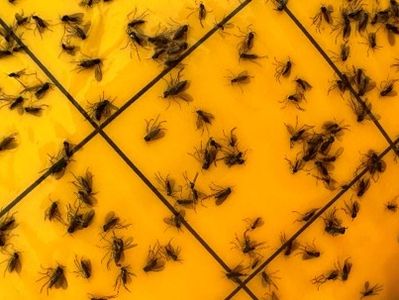FUNGUS GNATS
Biology and Identification
The term ‘fungus gnat’ has been used for members of two different families of flies: the Mycetophilidae and the Sciaridae (‘dark-winged fungus gnats’). However, the most significant pest species occur in the latter family (notably species in the genera Bradysia (found in various indoor crops) and Lycoriella (primarily pests of cultivated mushrooms). On a global scale, Bradysia impatiens is probably the most important pest fungus gnat, and has been associated with economic losses in indoor cultures of cucumbers, tomatoes, ornamentals, mushrooms, and various other crops.
Adults of most dark-winged fungus gnats (Sciaridae) range in size from about 1.6 to 3 mm, with the females being slightly larger than the males. The males have a prominent pair of ‘claspers’ at the end of the abdomen (pictured here) which are absent in the female: the abdomen of the latter tapers to a point and terminates in an egg-laying structure (ovipositor). Both sexes have long, slender legs and long, 16-segmented antennae that extend well beyond the head. The leading edge of both wings, and the 2 veins immediately below those edges, are noticeably thicker and darker than the remaining veins. Immediately below these thickened veins is another vein that divides into two branches towards the tip of the wing, forming a shape similar to a ‘Y’ lying on its side.
Adult fungus gnats are thought to ingest only water, nectar, insect honeydew, or liquid materials associated with decaying organic matter. They are attracted to the volatiles given off by damp growing media (and associated fungal growth), both for feeding and for egg-laying; for this reason, they are often a particular problem in growing media containing high levels of organic matter, particularly when it is kept damp for prolonged periods. This may occur in opened bags of media that have been exposed to moisture, or in crops growing under cool conditions when plant growth is slow and the growing medium does not dry out quickly enough between successive waterings. Under such conditions, adult fungus gnats may be seen close to the surface of the soil/growing media, moving with a characteristic ‘flitting’ motion along or just above the surface. Yellow sticky cards placed near the soil surface are useful for monitoring adult activity and numbers (see picture above). The adults are also strongly attracted to lights at night.
Adult females lay their eggs in cracks and crevices in the surface of the growing medium, often close to plant stems. The eggs hatch into small, legless larvae, translucent white in color, with a small, shiny, black head. There are four successive larval stages, with mature larvae reaching a length of approximately 6 mm prior to pupation.
The larvae feed mainly on decaying organic matter and fungal material in the growing medium, but will also feed on root hairs and eventually on the root itself. Hence large numbers of larvae can cause significant damage, particularly to young seedlings and cuttings that are not well-rooted and growing vigorously. Furthermore, larval feeding damage can facilitate infection of the root system by soil-dwelling fungal pathogens such as species of Pythium, Fusarium, and Verticillium. Adult fungus gnats can also become contaminated with fungal spores while feeding on pathogen-damaged plant tissues, and in this way may contribute to the spread of some fungal diseases between plants.
The life-cycle (from egg to adult) takes about 17–30 days, depending on temperature. Males typically emerge approx. 1 day before females and the adults live for about 4–8 days. Reduced survival of immature stages and reduced adult longevity are observed when temperatures regularly exceed 90 °F (32.2 °C).

Adult fungus gnats trapped on a sticky card
Copyright © 2022 Sierra Biological Inc. - All Rights Reserved.
Powered by GoDaddy
